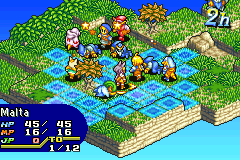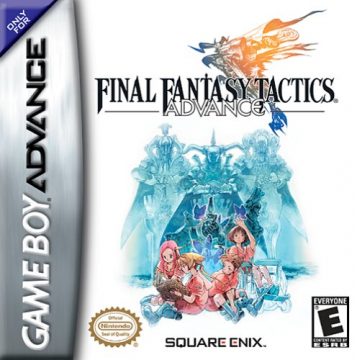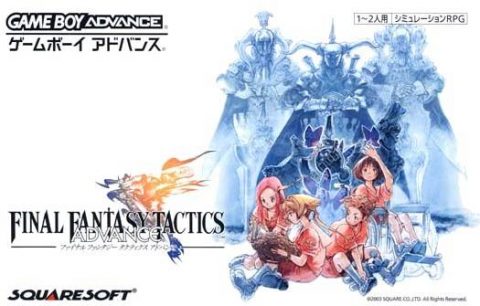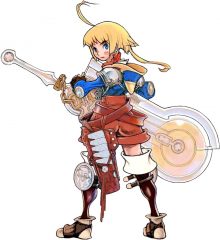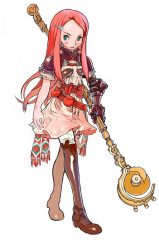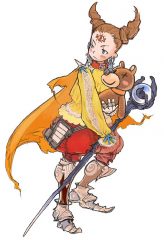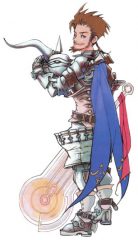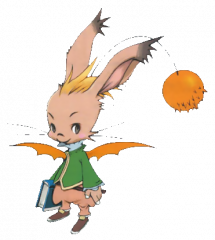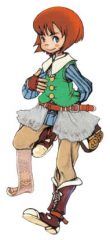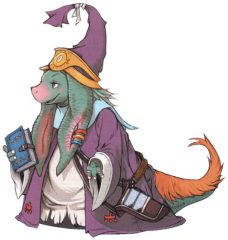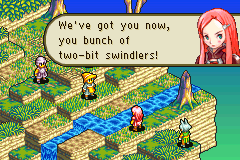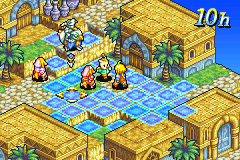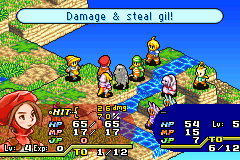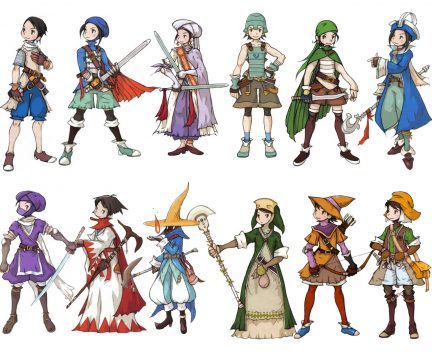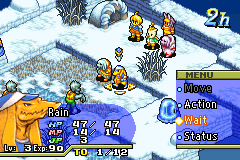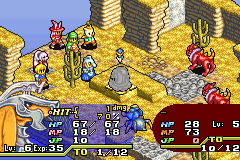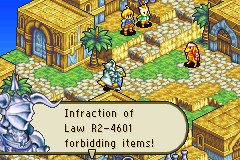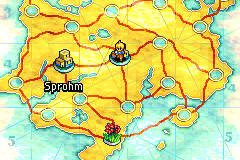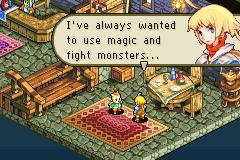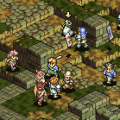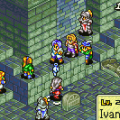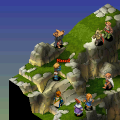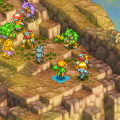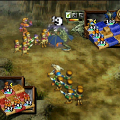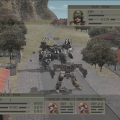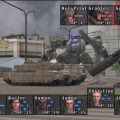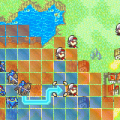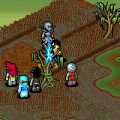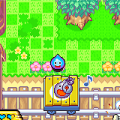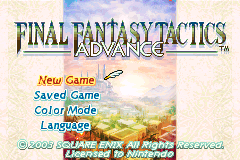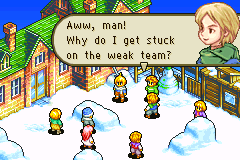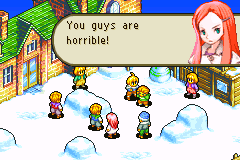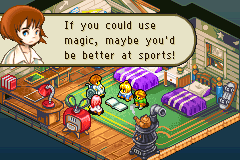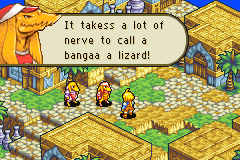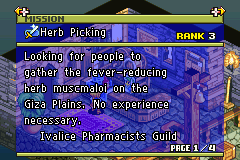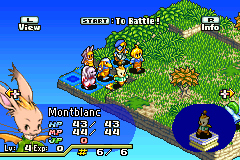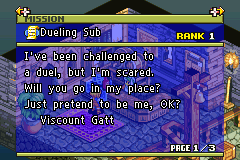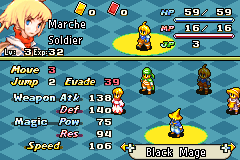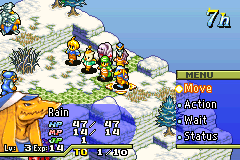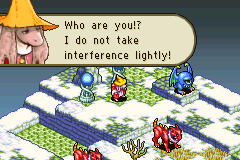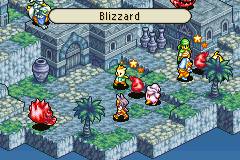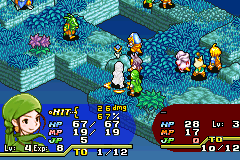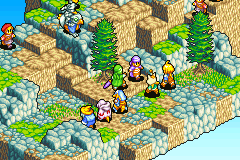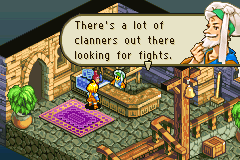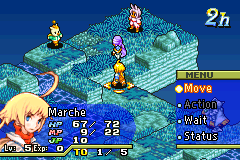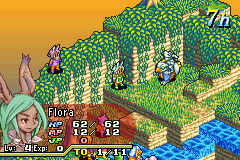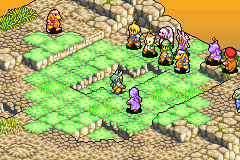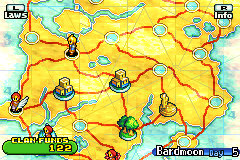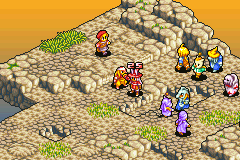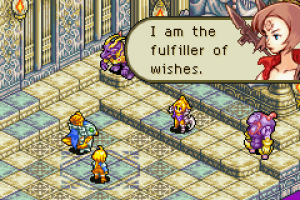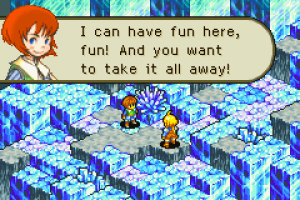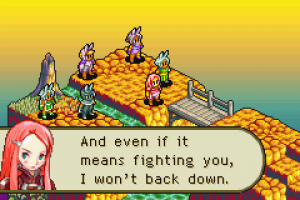- Final Fantasy Tactics
- Final Fantasy Tactics Advance
- Final Fantasy Tactics A2: Grimoire of the Rift
Final Fantasy Tactics was a huge success, though Yasumi Matsuno and his crew changed gears for their next title, the 2000 PS1 title Vagrant Story. From here, Matsuno was promoted to directing Final Fantasy XII, though after a number of years he ended up quitting the project due to various difficulties. In the interim, he acted as producer for a Final Fantasy Tactics spin-off for the Game Boy Advance, appropriately dubbed Final Fantasy Tactics Advance. The game was directed by Yuichi Murasawa, who had previously worked on Tactics Ogre: The Knight of Lodis.
Portable machines were aimed towards a younger audience than console games (and the previous Tactics games aimed at a more mature audience than a typical PlayStation owner already) so naturally the game had to be scaled back from the dense political tales that previously defined the series. Final Fantasy Tactics Advance actually begins in the “real” world, taking place in the city of St. Ivalice (probably a British or American location). The heroes are a group of children who discover a mysterious book called the Gran Grimoire, which causes the entire city to become enveloped in the world of Final Fantasy. They each take on different roles in this new, fantasy life, living out their dreams in ways they previously couldn’t in reality.
Characters
Marche Radiuju
The main character, Marche is a shy young boy who has recently moved into St. Ivalice. After being picked on by the neighboorhood bullies, he makes friends with Ritz and Mewt. Unlike the rest of the characters, who wish to remain in the fantasy world of the book, he actually wants to go back to the real world.
Ritz Malheur
A headstrong young girl who finds her place in the fantasy world as the leader of a clan with her own name. She’s ashamed of her white hair, which she dyes red in the real world, but is her natural color in the fantasy world. Regularly accompanied by a Viera named Shara.
Mewt Randell
A timid boy who ends up as the Prince of Ivalice upon being transported to Ivalice. He ends up being the antagonist of the story, since he has everything he wants. Accompanied by a Nu Mou servant named Babus.
Cid Randell
Mewt’s father is a divorced alcholic and negligent parent in the real world, but in the fantasy world, he’s the Judgemaster. His wife (and Mewt’s mother), dead in reality, is also alive here as the Queen.
Montblanc
A friendly Moogle, who meets Marche upon being transported into the book, and shows him the ropes of this strange new world.
Doned Radiuju
Marche’s younger brother, who’s wheelchair-bound in the real world, but can walk freely in the fantasy world.
Ezel Berbier
An eccentric oddball Nu Mou who despises the law system of Ivalice, and creates his own anti-laws. His main job is a Hermetic, which is similar to the Alchemist,
Though ostensibly based on Final Fantasy Tactics, this version of Ivalice is substantially different from the one previously seen. Any pretenses of being based on real historical war is dropped, as are most of the aspects of politics and religion. Instead, the focus is on the different clans that fight for control of the various territories. These fights are administered by Judges, who ensure that the combatants are following the laws of the land. Additionally, most of the cast of Final Fantasy Tactics were human; the Ivalice here is comprised of several races, including Humes (humans), the lizard-like Bangaa (but don’t call them lizards), the fluffy Nu-Mou, the rabbit-like Viera, and the old Final Fantasy standby, Moogles.
Rather than following a linear path of story battles, the focus here is on accepting and completing various missions, which are posted at the pub found in any city. At the outset, missions are few, but as you progress, the amount of potential quests greatly opens up, though some can only be accepted if you’ve already obtained specific quest items beforehand, so there is some semblance of linearity to them. Additionally, most of the map is empty when you first begin the game, and whenever a new locale is unlocked, you can place them on the map. This is a similar system to Square’s PS1 game Legend of Mana, where you can find different items from these areas depending on where you’ve placed them. (Of course, you can only really take advantage of this by reading strategy guides.) In addition to taking missions, members of rival clans also occasionally pop up around the map, which are similar to the random battles in the previous game. You can also fight with other clans to control territories, which has various beneficial effects, like lowering prices and adding more stock to the story. Your clan also has various stats, which level up as you win fights, and can give you additional items. As with before, there are also dispatch missions where you can send away your party members for a short period of time.
Given the move to the Game Boy Advance, the 3D battlefields are gone, replaced with 2D fields similar to most other isometric 16-bit RPGs. This means less complicated maps, as well as removing the ability to rotate them. Still, the visuals are pretty decent, with some detailed backgrounds and well-drawn sprites to accompany the various races and the myriad of jobs. The characters were drawn by Ryoma Ito, which don’t quite have the distinctive maturity of Akihiro Yoshida’s art, but are appropriate given the fantasy storybook setting. Seeing as the game was released late in the GBA’s life, with the availability of products like the GBA SP and Game Boy Player, there are actually three different video modes that switch the palettes appropriate for each platform, so they won’t look as bright or as washed out on backlit screens or on a television.
The music was again supplied by Hitoshi Sakimoto and Masaharu Iwata, with Final Fantasy series mainstay Nobuo Uematsu providing the main theme, and a few other composers (Kaori Ohkoshi, Ayako Saso) providing additional songs. As part of the team, the music is excellent, though the songs are generally more light-hearted than the dramatic war marches from the other games. The sound quality is pretty decent for the GBA too, mixing sampled instruments with the chiptune tracks in ways that are much more pleasant than most other games on the platform. The official OST release contains a second CD that contains the soundtrack played with improved synth, outside of the constraints of the portable hardware.
While the core of the battle system is similar to what’s seen in other Matsuno games, it’s also been heavily paired down. Everything about the Faith and Brave stats, and the Zodiac compatibility? Gone. Stats are more consistent with other RPGs, so armor and the like adds to a defensive stat. While turn order is still determined by speed, skills are executed instantly so there’s no need to figure out if an attack will hit. (There are still some charge skills that just strengthen a subsequent attack at the expense of a turn.) It’s still heavily dependent on hit percentages so you still want to attack from the sides, but otherwise it feels more like any number of other isometric SRPGs. There’s no timer on reviving fallen combatants either, and as such, no permadeath (with some exceptions).
Even though these elements are stripped back, there are a number of improvements – you can actually see where you’re placing individual units on the battle field, and you no longer need to commit to moving before attacking, so you can check to see if certain attacks will work and backup if they won’t. The difficulty level is also much, much lower, as enemies never hammer you with magic, debuffs or disabilities as heavily as they did before. Each character also starts with the Item ability, so no need to have them start as a Chemist first. All characters also regenerate 5 MP every round, which prevents magic users from becoming useless if their power runs out.
While the job system has been kept, it’s been given a gigantic overhaul. In the original Final Fantasy Tactics, every character could be almost any class – there were a few cases where jobs were dependent on gender, but they were rare. Here in Final Fantasy Tactics Advance, each of the five races have assigned job types, and can’t venture out of those. Humes are the most well rounded, Bangaa focus on physical attacks (Soldiers, Monks), Nu Mou on magic (Mages), Viera on speed (Archers, Fencers, Assassins), and Moogles have a variety of magic and dexterous abilities (Black Mages, Thieves, Gunners). Moogles also have some gimmicky classes like the Gadgeteer, which can inflict status effects on either the party or the enemies depending on a coin flip, and the Juggler, where you can toss various items with specific effects, sort of like a more concentrated version of the Ninja and their Throw ability from Final Fantasy V. There’s also no split between genders – all humans are male (except Ritz, a story character), all Viera are female, and everyone else is of indeterminate gender. There are also a handful of story characters, though some can’t change jobs at all, making them even more useless than they were in the original Final Fantasy Tactics.
Additionally, gone are the concepts of job points and job levels. Importing the system from Final Fantasy IX, all skills are learned by equipping a specific weapon. Points towards earning these skills are granted uniformly at the end of each battle rather than though action (experience points are still given per move, though) and new jobs are unlocked by learning a certain number of abilities from prerequisite classes. (Unlocking the Soldier requires two mastered abilities from the Fighter, for example.)
Many of these changes are attempts to give the game both some structure and balance, but it doesn’t really work for a number of reasons. The open-ended nature of the original was part of why it was so brilliant – you could unlock most classes fairly early on, if you put the work into it, whereas here you’re restricted in both job types and abilities, based on whatever pieces of equipment are available. There are a wide variety of jobs between all classes, and there is some overlap – Humes, Nu Mou, and Viera can all become White Mages, and even the Bangaa have White Monk and Bishop jobs that have some similar healing capabilities. Conversely, only Bangaa can become Dragoons, only Viera can become Assassins or Summoners. It isn’t quite the same when you can’t mix and match as before. Plus the game still has other assorted unbalances – Thieves can steal almost everything from enemies, which is important considering how much of an emphasis this game places on item gathering and Viera Assassins have a variety of overpowering stats debilitations and instant kill moves.
It should also be noted that, for as important as item management is in this game, the interface is an absolute nightmare. The battle scenes are generally fine, but when it comes to figuring out what classes can equip what items, what abilities they’ll teach, and what abilities your character already has (or is learning), it’s clear that the developers had trouble adapting all of this information to a system with such a low resolution display and such few buttons. Furthermore, the “Fitting Room” option from the original FF Tactics, which was hugely effective in determining the best outfits for each character, is gone. There’s not even an “optimize” function and those were found going back to Final Fantasy VI on the SNES. Also, in order to undertake certain quests, you need to have specific story items. In addition to being an annoying prerequisite, you can only carry a limited number of these at once, and need to juggle against ones that seem unimportant. If you ditch one that does end up having a use, then you may miss out on those missions permanently. It’s nothing that will cause the game to end, but there’s so much missable stuff that it makes the Zodiac Spear debacle from Final Fantasy XII (where a strong item was impossible to get unless you did very specific actions through the course of the game) seem trite in comparison.
For as much of a mess as all of this is, Final Fantasy Tactics Advance is more infamous for a particular egregious addition: the Law system. Each battle is dictated by actions that are either disallowed for promoted – sometimes they’re simple things like specific spells, but other times you can’t use specific types of weapons, or even use the basic “Fight” command. This, of course, requires that you use different team members, or switch around current team members to other jobs so they don’t violate any laws. Conversely, if you use the suggested attacks, then you’ll be granted JP (Judge Points, not to be confused with the Job Points in the previous game). These let you use powerful abilities, including combos, as well as Esper-like summon monsters called Totemas, which, as in Final Fantasy tradition, are based off enemies from previous games.
For the most part, the laws are dictated by a calendar, so you can check ahead to see what laws are in effect and then schedule battles in your favor by moving around the map. But it’s very easy to ignore this if you’re not careful, since many times you’ll just end up with laws that have no real consequence anyway. Furthermore, again due to problems with the interface, it’s difficult to see what laws are in effect, so it’s easily to accidentally break them.
The effects of breaking laws depends on the infraction – sometimes you’ll just get a penalty card, but other times you’ll be sent to jail, removing them from the mission and requiring that they be bailed out. If Marche gets arrested, it’s an instant game over. Sometimes you’ll even lose stats permanently. Conversely, the enemies can break laws and have similar penalties – the AI isn’t all that smart about following them, so you can manipulate these in your favor. Later on in the game, battles can have multiple laws, and you can even nullify current ones or write your own, though certain enemies that wear Hero Medals are impervious to them anyway. (There is actually an in-game explanation for this, at least.)
The laws are administered by the Judges, who appear on the battlefield and have their own turn, though they don’t actually do much of anything. You can’t attack them and the only thing they actually do, other than awarding JP or throwing penalty cards, is teleporting fallen soldiers around the map so they don’t get in the way…though they often do this badly. The exceptions to all of this are the Jagd areas, which exist outside of Ivalice’s rule. Here, there are no judges and hence no laws…the downside being that characters can actually get permanently killed here, if you fail to resurrect them.
Everything about the Law system is something that seems interesting on paper but is just largely dumb in practice. It creates needless obstacles if you don’t pay attention to fighting on the right days, and the fact that you can manipulate it anyway makes it mostly pointless anyway. Its original Japanese release was even more problematic, containing some Laws that were extremely difficult to adhere to, or just plain stupid (“don’t do less than a certain amount of damage”, for example). Most of the more annoying ones were removed or changed before it was localized outside of Japan, at least.
On top of all of these other changes and issues, there’s the game’s story. The fact that it’s moved to a modern day fantasy story isn’t really a problem (in fact, the snowball fight that acts as a tutorial before the world turns into Ivalice is pretty charming) and moving away from the super serious plots that Matsuno typically tells isn’t necessarily bad either. But the stories in previous Tactics games were consistent – there were always story missions to fight if you wanted to continue, and random battles if you wanted to level up. Here, the missions are so scattershot that several battles can pass before you get a story scene, so the pacing feels sporadic.
The nature of the story is actually pretty interesting though – it seems fairly light hearted at first, and it is in comparison to other similar strategy games, but it does get a bit darker in the ways that mirror how people use games to escape reality. While Marche enjoys his status in the clans, he still wishes to return to his regular life. The rest of his friends don’t feel the same way – Ritz has the naturally colored red hair she always wanted, Cid is actually competent, Doned can walk, and Mewt is literally prince of the kingdom. None of them want to leave, which would be almost fine if they were the only people in Ivalice. But it’s eventually revealed that all of the regular folks in the town have also been swept into the story, and not all of them are happy about it either. As such, Marche ends up fighting the desires of his friends in order to take them back to reality, and with that, destroying the fantasy they’ve created. There have been many message board posts over the years surmising that Marche is actually the villain of the story, which is a valid reading, though not one the game really stands behind. Due to the interplay between the “real” and “fictional” world, comparisons can be made to The Neverending Story, though more so the original book than the sanitized (and cutdown) movie adaptation.
At any rate, the story is structured the way it is is for the same reasons as the mission and job system – this primarily presented as a game where you can either hop into for twenty minutes to play for a quick session, or potentially plays for hours just concentrating on the many side-missions or character grinding. These aspects were part of the original Tactics games, but that “jump in and play” is more strongly emphasized, along with the focus on loot gathering. After all, there are 300 missions, which suggest a hugely long playtime (though there are only 24 or so that are required to beat the main game), which is perfectly suited for a handheld format.
But still, it’s hard to make the argument that any of these make for a better game. Some of the simplification is welcome, considering how overwhelmingly difficult both Tactics Ogre and Final Fantasy Tactics could be at times, but what changes it does make seems more intent on prolonging the playing time rather than enriching it. And that’s including the missteps in the equipment and law systems.
Yet all of this generally works primarily because the core gameplay systems are still in place, and they’re still as addicting as ever. While the game is more like “Final Fantasy Tactics Jr”. than “Final Fantasy Tactics 2”, it’s still one of the better SRPGs on the Game Boy Advance. It’s certainly an improvement over its brother, Tactics Ogre: The Knight of Lodis, which suffered from assorted technical issues, plus it looks and sounds much better. The result is a game that will probably be disappointing to series veterans, but is more welcoming to genre newcomers, and is pretty decent in its own right. However, the follow-up, Final Fantasy Tactics A2 for the DS, fixes many of the problems that this game has.
Interestingly, Final Fantasy XII continued with the setting of Ivalice, though it’s closer to this game than to the original Final Fantasy Tactics. It includes the Bangaa and Viera races (though the Nu Mou look different). Several locales introduced in this game reappear in Final Fantasy XII, like the Giza Plains and Salikawood. The Moogles here are redesigned to have more rabbit-like ears (though the sprites resemble the way they look in the 16-bit Final Fantasy games), and that redesign is reflected in Final Fantasy XII as well. Judges play a big part too, though they’re more antagonistic in FFXII, where they’re (mostly) neutral in FFTA.
In addition to lessening some of the more annoying laws, there were a few other tweaks made for the English release, including turning characters that were previously NPCs, like Ritz, Cid, and Babus (Mewt’s Nu Mou servant) into playable characters, as well as some expanded story scenes. The number of quest items was also doubled from 32 to 64, making it easier to accept certain missions. However, in the Japanese version, Cid is portrayed as a drunk. Probably desiring to keep an “E” rating for the ESRB, references to alcohol were removed, so in the English version, he’s instead more of a depressed loser. Most Final Fantasy games receive similar tweaks and additions to localized versions, and are then re-released in Japan. Final Fantasy Tactics Advance, however, was not, leaving some resentment among Japanese fans that only overseas players got the superior version.
